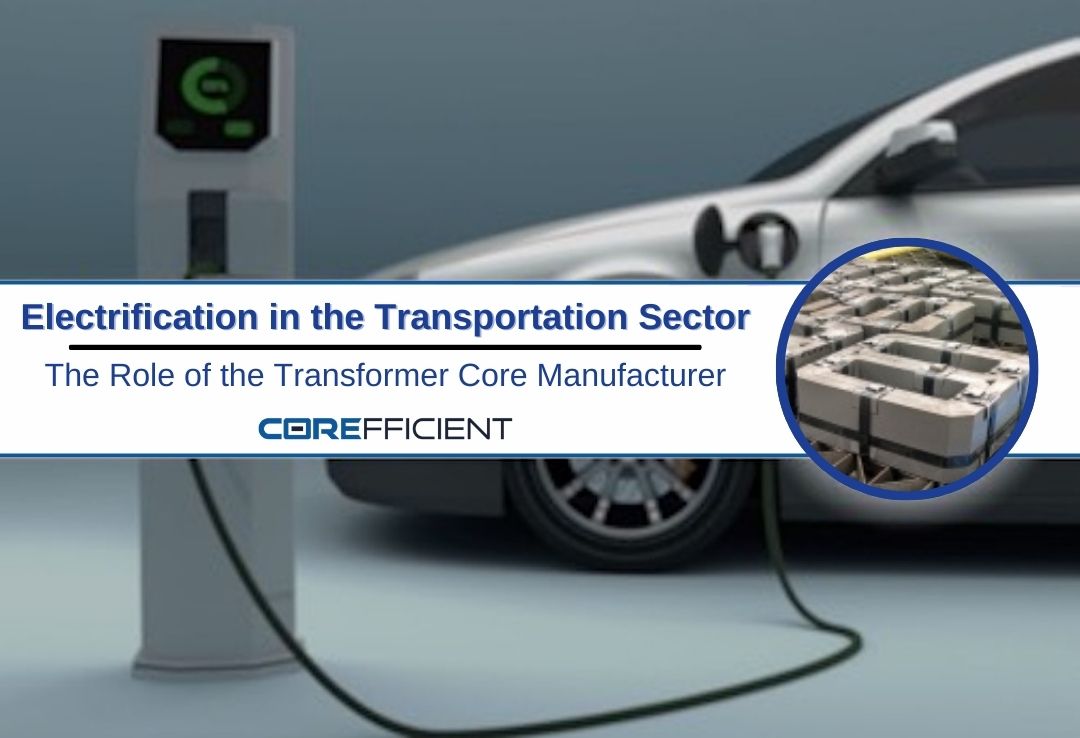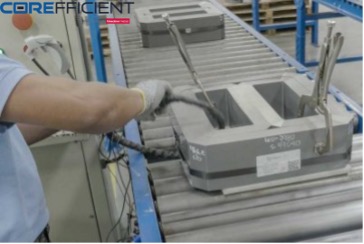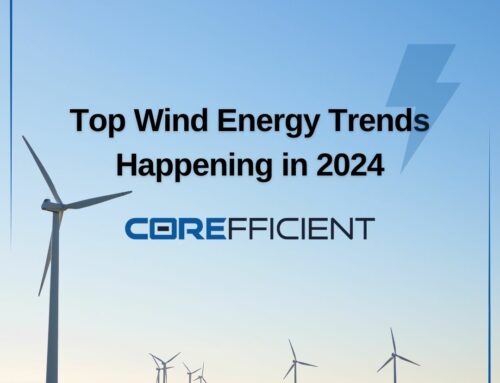
The roar of engines is slowly fading, replaced by the quiet hum of electric motors. The transportation sector is undergoing a seismic shift driven by the electrification movement. As electric vehicles (EVs) become more mainstream the demand for a robust and efficient charging infrastructure has never been higher. This is where the unsung heroes of the electrification revolution come in: transformer core manufacturers.
The sleek and modern design of electric vehicles often captivates the public’s attention. However, it is the pivotal role of transformer core manufacturers in ensuring seamless and efficient power delivery to charging stations that truly drives the future of transportation.
At the core of this revolution is Corefficient, a leading transformer core manufacturer. They ensure smooth and efficient power delivery to EV charging stations, paving the way for a sustainable future.
Building a Sustainable Transportation Future
Climate change is a pressing challenge, with the transportation sector being a primary culprit, contributing 24% of global carbon dioxide emissions. We must shift towards cleaner alternatives to mitigate this threat and build a sustainable future. The electrification of transportation emerges as a powerful solution. We can significantly contribute to our planet’s health by using clean energy to power EVs, which will help reduce greenhouse gas emissions.

Building Blocks of Powering Electric Vehicles
However, ensuring a sustainable future requires us to go beyond the vehicles. We need to focus on the building blocks of powering these EVs: clean, green, and renewable energy.
- Clean energy: While not constantly renewable, clean energy offers sources like nuclear power that minimize emissions during operation. This helps us diversify our energy mix and reduce reliance on fossil fuels.
- Renewable energy: Like wind, solar, and geothermal, replenishes naturally, offering a long-term sustainable solution. It allows us to power our transportation sector without depleting finite resources.
- Green energy: Green energy is a subcategory of renewable energy and representing the ideal scenario. It encompasses solar, wind, and hydropower sources with minimal environmental impact throughout their entire lifecycle.
Therefore, as we move towards an electrified transportation future, it’s crucial to incorporate a diverse mix of clean, green, and renewable energy sources. This approach ensures a reliable power supply, minimizes environmental impact, and paves the way for a sustainable future. The combined efforts will address the looming threat of climate change, leading us toward a cleaner and healthier world.
Updates on Electrification Progress
Transportation electrification is crucial to combat climate change and achieve a cleaner and greener future. The world has made remarkable progress in this sector, as evidenced by surging EV sales, supportive policies and incentives, increasing investments in charging infrastructure, and advancements in battery technology and EV range.
A. Surging EV Sales Worldwide
In 2021, despite the COVID-19 pandemic and the economic downturn, there was a significant increase in global EV sales, which reached a record high of 6.75 million, representing a 108% surge from 2020. It is the first time since 2012 that global EV sales doubled in one year. Several factors have contributed to the growth of EV sales, including increased consumer demand, reduced costs, wider availability of models, and supportive policies. China, Europe, and the United States were the three major markets for EVs in 2021, accounting for 85% of the global sales.

A report by BloombergNEF suggests that EVs have the potential to make up 58% of new car sales and 31% of the worldwide car fleet by 2040. This shift could lead to a reduction of 17.6 million barrels of oil consumption per day. It could prevent 2.4 gigatons of carbon dioxide emissions annually. However, to achieve this scenario, more efforts are needed to accelerate the adoption of EVs, especially in emerging markets and in other transport modes, such as buses, trucks, and two-wheelers.
B. Government Policies and Incentives Promoting EV Adoption
Countries worldwide are promoting EV adoption through subsidies, tax incentives, and regulatory measures to lower ownership barriers and foster a supportive environment. For instance, the EU’s 2035 zero-emission vehicle mandate and goal for 3.5 million public chargers by 2030 aim to phase out gasoline and diesel cars, enhancing EV demand.
A funding opportunity of $99.5 million has been declared by the US Department of Energy (DOE), along with the selection of 45 projects totaling $87 million aimed at advancing EV technology, training professionals, and ensuring equitable access to clean mobility in underserved communities. The announcement supports the President’s Investing in America Agenda and the U.S. National Blueprint for Transportation Decarbonization, which seeks to achieve a fully decarbonized, clean transportation future. The projects will cover various aspects of transportation electrification, such as EV charging, batteries, education, and low-emission solutions across various modes of transport.
Various nations, including China, Japan, India, South Korea, Canada, and the United Kingdom, have introduced measures and encouragements to endorse the acquisition of EVs, such as financial aid, tax benefits, fuel economy regulations, emission objectives, and restrictions on cars with internal combustion engines.
C. Investments in Charging Infrastructure Development

Investments in charging infrastructure development are crucial for EV adoption, providing users convenience and confidence while ensuring power grid integration and stability. Post-2020, the IEA reported around 11.3 million global EV chargers, with 1.3 million public ones. Yet, the public charger-to-EV ratio stood at 0.19, below the advised 0.5, indicating uneven availability and access across regions, and often a mismatch in charger types.
To tackle this issue, governments, utilities, and private sectors are boosting investments in charging infrastructure, focusing on fast and ultra-fast chargers. These advancements aim to shorten charging times and enhance convenience for EV users. For example, in 2021, Shell announced a plan to install 500,000 charging points by 2025, up from 60,000 in 2020. Similarly, ChargePoint, one of the largest EV charging networks in the world, raised $127 million in 2020 to expand its operations in North America and Europe.
D. Advancements in Battery Technology and EV Range
Battery technology is the core component of EVs, as it determines its performance, cost, and environmental impact. In the last few years, battery technology has significantly improved, resulting in increased energy density, reduced cost, longer lifespan, and lower emissions.
According to the IEA, the average energy density of lithium-ion batteries increased by 85% between 2010 and 2020, while the average cost decreased by 89%. The average battery pack size increased by 50% between 2015 and 2020, reaching 44 kWh in 2020. These improvements have enabled EVs to achieve longer driving ranges, lower prices, and higher efficiencies.
For example, in 2020, the Tesla Model 3 had a driving range of 568 km, a price of $37,990, and an efficiency of 0.15 kWh/km. In comparison, in 2010, the Nissan Leaf had a driving range of 117 km, a price of $32,780, and an efficiency of 0.21 kWh/km.
However, there is room for further improvement in battery technology and EV range, primarily to compete with conventional vehicles and meet the needs of different users and markets. Some of the challenges and opportunities include reducing the dependence on critical materials, such as cobalt and nickel, increasing the recycling and reuse of batteries, developing new chemistries and architectures, such as solid-state and lithium-sulfur batteries, and enhancing the safety and reliability of batteries.

That’s where Corefficient comes in.
Corefficient is a leading transformer core manufacturer, specializing in producing energy-efficient transformer cores. Their advanced transformer core designs are renowned for their superior efficiency, which helps to reduce losses and improve the power quality of the electricity supply for the EV charging infrastructure.
With their expertise and experience, Corefficient provides tailored solutions for the evolving needs of the EV charging infrastructure. The commitment to sustainability that Corefficient has is evident through their eco-friendly transformer core manufacturing practices. They’re not only the leading transformer core manufacturer, but also a proud advocator for environmental stewardship.
If you’re looking for the best transformer core manufacturer in the industry, Corefficient is the perfect choice for you.
More About Corefficient
A division of Kloeckner Metals, Corefficient leads the transformer core industry, focusing on enhancing the value of its products. With expertise in transformer core engineering and design, magnetic cores, and materials like hot and cold rolled steel, grain-oriented and electrical steel, Corefficient stands out for its commitment to quality and exceptional customer service. This dedication has positioned Corefficient as a trusted partner in energy-efficient transformer core manufacturing.
For more information on Corefficient’s offerings or to make inquiries, please visit their website at www.corefficientsrl.com or contact them at 1 (704) 236-2510 for North America and (81) 2088-4000 for Monterrey, Mexico. Corefficient is eager to assist you with your electrification projects and looks forward to your contact.





